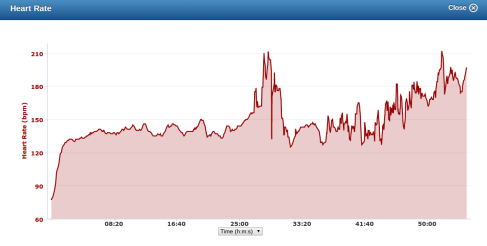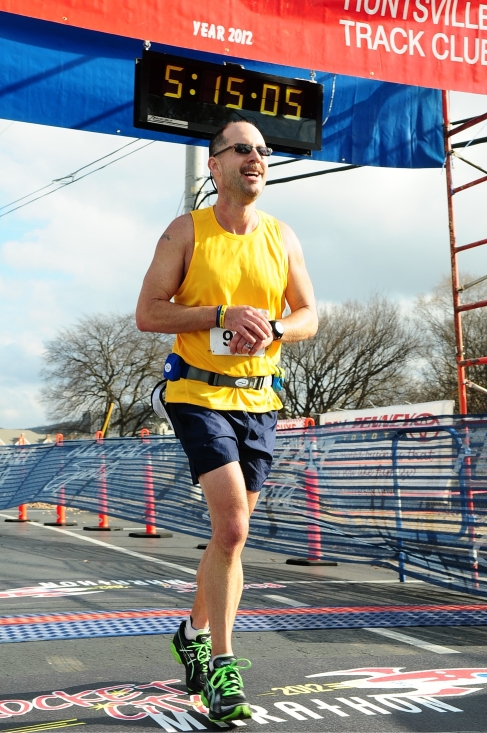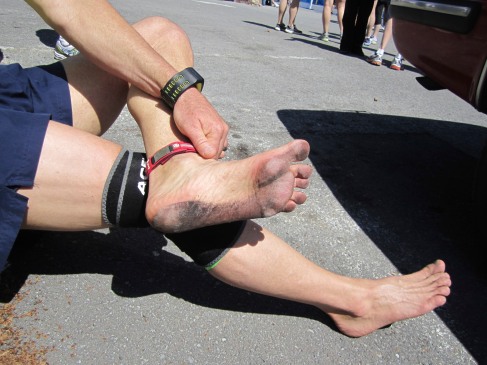My Run to the Hospital…
Posted by barefootclay
I intended my 4.5 mile run through downtown on Tuesday as an “easy” run but now have to call it my “hospital run” because that’s where I ended up afterward.
Despite a slow pace, my heart rate went waaaay over my maximum possible of 179. I hit 212 bpm. I sat, rested, then tried again and it went into the 200’s again. I laid down on grass, got it lowered, then as soon as I tired to run again, it shot back up. My average for the last mile (which I pretty much walked) was 185, still over my max. Kinda scared me, so I went to see the City Nurse after my run and he said I had an irregular HR even then, 30 minutes later. He sent me to the ER.
Six hours an IV and 12 vials of blood samples later, I was told I had preartrial fibrillation, a common form of cardiac dysrhythmia. No heart damage, just something to watch and be careful about. If I’m racing and it happens, I’m supposed to lie down until it passes as everyone else passes me. The idea of laying down during a race is not sitting well with me, but I’m trying to accept that I may have to make that decision.
I’ve attached a screen shot of my Garmin’s HR monitor pattern for this run. Keeping in mind my “pass out at the finish line” max bpm is 179, this pattern was pretty wild for me.
A memorable run, to put it mildly.
Posted in Barefoot Running
Tags: cardiac dysrhythmia, heart rate, monitor, preatrial fibrillation, running
Attacked by Plantar Fascitis!
Posted by barefootclay
I ran my first marathon (The Rocket City) in December 2012 and 
had a freakin’ blast, but I’ve been going downhill ever since, up until last week.
I was hesitant to write about this, but after looking back over the tracking I’ve done with my Garmin over the past few months, I thought posting about what little running I’ve been able to do since the plantar fascitis hit me might help someone else with it see the light at the end of the “carpal tunnel,” so to speak.
I’ll be honest, dealing with this and having to scale back, and then not run at all, during the last several months has been more depressing than I’d anticipated. Don’t get me wrong, I was not clinically depressed, but my PF was not something I wanted to talk about as I went through it because that just reminded me more of what I was missing. I wasn’t sure when I’d be able to train (much less race) again. Instead of running, I researched.
I cross trained as able, used a foot splint at night, applied massage and ice, elevated, changed shoes, tried to walk barefoot every chance I got, and read tons of medical and running articles about PF. What finally appears to have cured me has been the combination of the following: Not running at all, very very (very) frequent foot massage, going barefoot as much as possible to rebuild the musculature in my foot after apparently having destroyed some of it during the marathon and 5K, and wearing a night splint to keep the bottom of my foot stretched as it healed at night. I’ve also quit using the shoes I wore during the marathon and 5K that resulted in my getting PF, and I’ve changed my work shoes as well. I’ve switched my running shoe to a 4mm drop shoe, added a mild hard arch support to those shoes (in fact, I use them in every shoe I wear), and I slowly brought barefoot running back into the mix as I healed.
I’m not completely pain free as I write this, but the PF area under my left foot is a soreness, not a stabbing knife-like pain as it had been. For those curious, I’m running in Skechers Go Run Ride shoes (4mm drop, but with more protection underfoot than the Go Bionic’s and a wider toe box than the Go Bionic’s) and I replaced the inserts with Superfeet “blue” hard inserts. When I’m not running in those, I’m running barefoot.
I am also dropping the 20 mile weekly long run and switching my training to utilize the Hanson-Brooks methodology, where daily runs are longer and the long run is done pre-fatigued but does not go past 16 miles, to emulate the last 16 miles of a marathon.
We shall see what happens 🙂
20 mile run in Vibram FiveFingers & barefoot
Posted by barefootclay
Today’s 20 mile training run proved to me the aphorism “always train the way you intend to race” is ABSOLUTELY great advice!
I was feeling strong and holding a steady 12 min/mile pace in my Vibram Five Fingers through the first 11 miles around Hazel Green. Then at about 11.25 miles, the middle toes on my right foot went numb. I took off the VFF’s and shed the Injini toe socks I’d added to prevent blisters, rubbed the feeling back into my toes, and continued. I made it another mile in the bare VFF’s before I had to stop again. Best I can figure, as my feet slowly swelled with the mileage, somehow the VFF’s were crimping the nerves in my toes. I slowly made my way to a Sonic restaurant, stopped for about 20 minutes to refuel, massage and elevate my feet, then continued on.
I felt better, still in VFF’s, and pressed for more mileage. Up until about 17. Then it got bad; the numbness struck again and it felt more serious. I shucked the VFF’s and started to call my wife to ask if she’d bring me my Nike Free Runs. I’ve done several 20 milers in them without issue, and I wasn’t about to quit at mile 17 unless I was limping or bleeding.
I got out my cell and as I was about to dial, I realized my bare toes could feel the asphalt.
“Hey, I have feet that work!” And plan B was implemented.
I ran miles 18 through 20 barefoot, without experiencing any numbness. All in all, a little scary, but a highly educational run! Thanks, all my running buddies! If that VFF numbness had occurred during a full marathon, I undoubtedly would have pushed on, and might have caused myself serious damage.
Lesson learned? Aways listen to your friends, pay attention to your body, and don’t lock yourself into preconceived limitations 🙂
Posted in Barefoot Running, Running
Tags: Barefoot, FiveFingers, hazel green, long run, sonic restaurant, sports, toe socks, training run, VFF, Vibram Five Fingers
The Elephant on the Greenway: Why Do I Run Barefoot?
Posted by barefootclay
This question is usually asked of me more through perplexed facial expressions than orally. I smile as I run barefoot with my little elephant down the greenway, and as I give a wave to each oncoming runner and walker, I read the question in his returned smile and raised eyebrows. Sometimes I see the question in her dropped jaw as I turn to say “hi” to a fellow runner I’ve apparently snuck up on and scooted around. My feet are almost always turning over twice as fast as do those shod with clod hoppers. By the time I’ve lapped my fellow exercise addicts, I can tell my methodology has been discussed and someone in each little group has been appointed—should they see me again—to raise the question of my barefoot elephant.
“Doesn’t that hurt?” is spoken a lot.
“Not right now.” And I smile.
It is in my nature to smile at people and wave “hi.” I like to see people happy, and my smile often helps uncover their smile. The added benefit is, folks see I’m not in pain. The elephant hasn’t stomped on my toes. That’s important. Especially if I’m traversing rocks, gravel, twigs, glass, or other objects that—in their minds—could leave a trail of blood behind me. I don’t pretend to imagine these shod runners and walkers fear for my safety, since they don’t know me and I could just be crazy, so much as they fear what could happen to them if they shucked their shoes and ran unshod.
So why do it?
Mostly, because mud between your toes feels fun. Mud on the bottom of your shoes doesn’t elicit a “feel.” Running with knees VERY bent and using your legs as shock absorbers makes your legs feel powerful. Your knees don’t hurt during or afterward. For me, running into concrete or asphalt with the heels of cushioned shoes is jarring to my 48-year-old joints. Even the thickest heel cushioning causes me pain in my shins and knees if I heel-strike into the ground (that’s why I call it running into the ground, instead of running over ground).
What works for me may not work for you. That’s a given. But that said, I do believe we were created with a body born to run, and given a brain that enables us to do so safely. I’m not married to running barefoot any more than I am married to running shod. The terrain, my intended speed, and my intended distance govern to what degree I protect my feet—much as we all vary our degrees of clothing for each season and the elements.
The constant in my running is that no matter what level of protection I employ—mere thick skin underfoot, minimalist shoes, or thick zero drop trail shoes—I run as I was born to, with a natural forefoot strike and bent knees. This methodology helps ensure that every run feels good.
That’s why I don’t mind running the greenways with my little barefoot elephant. Because for me, an elephant on the greenway is a ton of fun :-).
Posted in Barefoot Running
Tags: Barefoot, Barefoot Running, greenways, minimalist, training, why I run
Why Justin Bieber and Gun Timing are both Dangerous!
Posted by barefootclay
Justin Bieber and gun timing can both get you hurt, bad.
Most people think Justin Bieber is this nice, talented kid who wouldn’t hurt the face paint on a ‘tween. Likewise, road race organizers who want nothing more than to raise funds for a great charity certainly never intend to hurt anyone. And yet the Bieb-ster and race organizers do get people hurt. It needs to stop.
Road race officials seem oblivious to the danger presented by gun timing. My guess is, its been years since those officials ran in the middle of the pack at a 5k with 5,000+ participants. The feel in the middle of such a large race can be akin to the claustrophobia of a rock star’s concert as the fans surrounding you crush toward the stage. When the gun sounds the start of a race, or when that rock star is launching into his greatest hit, the push forward from the crowd can make you feel on the verge of being trampled. People have died from the crowds at rock concerts, not yet at a road race that I know of… but the safety concerns are the same whether you are stuck in the middle of a bunch of screaming Justin Bieber groupies or a bunch of “Pink Ribbon Dash” breast cancer survivors…everyone needs to come out of the event unhurt.
The solution in both instances is greater organization of the event with an eye toward participant safety. In real world terms, that means doing away with the reason everyone feels the need to crush toward the front of the event. At a concert, technology now permits large viewing screens so the groupies at the back of the arena floor can remain where they are and still see up Justin Bieber’s nostrils and down his throat as he croons to them. At a road race, timing chips now permit slow racers to stay at the middle or the back of the starting pack but still race on a level playing field (so to speak). That is, unless awards are based on gun time.
Think about it what gun time causes people to do. A 70-year-old man who runs a 14 minute mile has to start the race with his toes on the start line if he wants a shot at an age division award. And who is he lined up with? The 13-year-old who also runs the same speed and wants to win her age group, and the elite racer who runs a 4 minute mile and wants to win first place. Multiply those three examples by 5,000 participants, most of whom would love to place in their respective age divisions, and everyone is clogged on the starting line thanks to gun time awards.
Several respected, large marathons utilize gun time for overall awards and chip timing for age group awards. Birmingham’s Mercedes Marathon is one such. Note the 2013 Prize Structure at the Mercedes Marathon:
- “Overall cash winners are not eligible for age division awards. If you think you may be a contender for an overall cash award then we suggest you cross the start line timing pad as soon as possible.
- Age division awards will be scored and determined based on Marathon Chip Time NOT Gun time.
- Again, please make note that GUN TIME time is used to determine all cash prizes”
These marathons inform the racers repeatedly on race day via multiple speakers positioned down the line of racers that they should start in the area designated for the pace at which they race. Participants are reminded, repeatedly, that chip timing allows each slower runners’ delayed crossing over the start line to still be a competitive start for age group awards.
That’s why, in a marathon with 25,000 racers and chip timing, a middle of the pack runner feels less crowded than does that same runner at a 5,000 person 5k with no chip timing.
My personal experience was that in the 25,000 runner pack, I was never trampled and never felt claustrophobic. In a few large, local 5k and 10k races where chip timing was either not used for awards or not used at all, I’ve been pushed, jostled, tripped, and had the heel of one shoe stepped on from behind and come off my foot. My overall race experience has always been much better with the much larger, but less aggressive, crowds.
Big screens save little feet from being trampled at Justin Bieber concerts. Its time we based age group awards on chip timing at large 5k races, in order to save our little racing feet.
Posted in Barefoot Running
Sonic Runs
Posted by barefootclay
I run 20 mile circles around a Sonic.
No, I don’t own stock in the company, and I’ve never worked at one. But I love the Route 44 Diet Cokes with Diet Cherry added. I won’t say I’m addicted, but, taking into consideration my love for this particular restaurant chain, and adding it to my compulsion to run, plus a dash of type 2 diabetes thrown in that makes me have to watch my sugar levels carefully, and the mixture leads me inevitably to run around a Sonic Restaurant.
Once I’m acclimated to the heat and humidity of summer running in Alabama, I can comfortably go my first 3 miles with no water. After that, I suck fluid from my Camelbak like a skinny tick on a fat dog. I’ll go through 20 ounces or more during every hour I run, and after the first hour of running, I need electrolytes added to my drinks. My Camelbak is a lightweight 1.5 L pack, easy on my back during a long run, but hardly the capacity I require.
A run of this magnitude, lasting about 4 hours and covering 20 miles or more, therefore requires planned hydration stops that can replenish both the water and electrolytes I’m sucking down. The simplest solution to my hydration needs (both real and my imagined addiction to those 44 ounce cups) is to loop by a Sonic every 8+/- miles. Two passes–two pushes of that beautiful red button that beckons a girl on roller skates to fulfill my 44 ounce addiction–and I’m good for the long run.
If your own long-run hydration needs are not being met by your water bottles, or Camelbak, do take into consideration why the order button at Sonic is red: It’s there to push in case of hydration emergencies 🙂
(Note: If you run topless, as I often do, please carry a shirt with you to put on when you order from the patio. Sonic is a family restaurant, after all. LOL)










